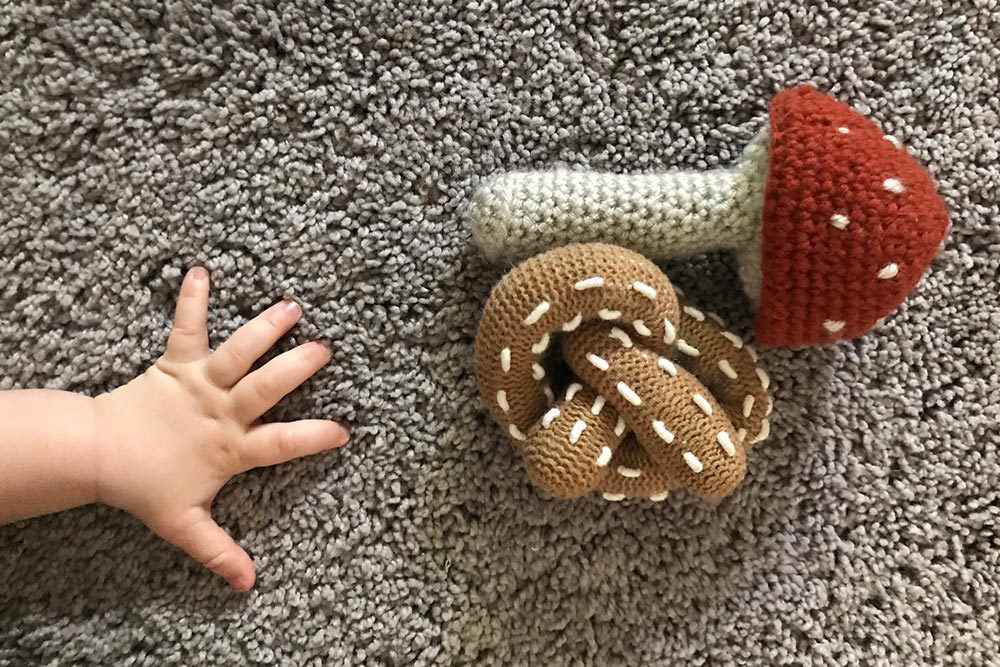Is Baby Bored?

Five ways to keep your growing sprout mentally stimulated (and why a little bit of boredom might be better for baby than you think).
Whether you position Mozart-blasting headphones on your pregnant belly to foster baby’s development or opt for the “later is greater” philosophy, all parents and caregivers want to raise intelligent, creative children. So when we see infants staring into space looking bored as a, well, board, we leap into action—we shake rattles, switch their positions, turn to tummy time, enlist educational programming, dance, make faces, power up brain-building gadgets. Why? Because baby boredom is bad, and a bored baby is not a mentally stimulated baby. Right?
Wrong, say experts. In fact, efforts to prevent boredom could be detrimental for young children. “Constant amusement, or not allowing our kids to be bored, is inhibiting their creativity and imagination,” cautions Joshua Straub, PhD, author of Safe House: How Emotional Safety Is the Key to Raising Kids Who Live, Love, and Lead Well.
A seemingly bored newborn baby is experiencing the world differently than we do, but he’s no less mentally stimulated. In fact, many of the ways we help babies develop into creative, self-entertaining adults go against our natural grain.
So don’t feel bad for giving your little one some downtime every once in a while. And in between those lulls, try these five tips for keeping tots engaged—without going overboard.
Keep Things Quiet
It isn’t in our nature to allow baby to simply stare at the ceiling fan, but that’s precisely what he needs: quiet, uninterrupted time to muse.
One benefit of providing some quiet time is increased attention span. “A baby can pick up an object, play with it for 10 minutes, and do everything you could possibly do with that object without any instruction from any adults, if [he has] the time to do it,” explains Ruth Anne Hammond, infant/toddler consultant, and author of Respecting Babies: A New Look at Magda Gerber’s RIE Approach.
An uninterrupted child stretches his ability to focus by concentrating on an object or task for an extended period of time. “Every time we interrupt baby’s musings, we discourage his concentration,” reveals Janet Lansbury, parent educator and author of Elevating Child Care: A Guide to Respectful Parenting.
An equally important benefit to downtime is that children who have the chance to rest their minds after being stimulated develop into more creative adults. Daydreaming is when the sparks of creativity ignite. If those reprieves are replaced with overstimulation, creativity can’t get a foothold, and children learn to expect external entertainment ’round the clock.
“It really starts as young babies because they develop a habit of being constantly stimulated and don’t really enjoy the benefits of that daydreaming time,” cautions Hammond.
Staring into space is powerful brain-building time—hang a “do not disturb” sign on the crib, and let baby muse.
Turn Off the Screens
Have you noticed when you turn on a screen in a room full of children (or adults) all eyes lock on and lips lock shut? It’s human nature. Screens are highly stimulating devices. Unfortunately, this is not the kind of mental stimulation a new baby’s developing brain craves, especially during his first five years.
Despite the popularity of educational programming and apps developed with the intention of improving a tot’s mental focus, the opposite often happens. The rapid image change on most shows, apps and video games sets the entertainment bar high for budding brains. One popular children’s educational program about farm life flashes through roughly seven scene changes every 20 seconds. “Send your kid to school a few years later to study farm animals, and at school it becomes boring—the lessons are too slow,” says Straub.
Screens may help your child quickly master basic rote educational skills, like ABCs, 123s and a dozen Spanish words, but they aren’t always the best learning tool. “What you’re sacrificing are the higher-level executive functions of your child’s developing brain—the ability to problem-solve, display behavioral control, regulate emotions, plan, negotiate and delay gratification—all critical components for both academic and social success,” warns Straub.
It’s up to you whether to pull a receiving blanket over baby’s eyes and whisk him from the room the second the Super Bowl flips on. But it’s wise to avoid consistently using the screen as a babysitter, teacher or entertainer for at least the first year or two.
Opt for “Basic” Toys
A baby’s world can be a veritable circus of gadgets, lights and sounds. Everything from musical bears to that must-have entertainer lines a baby’s nursery before the tiny occupant even moves in. It’s true: High-activity toys are stimulating in the moment. But new toys that don’t require batteries can also boost your wee one’s development.
Some of your babe’s playthings might seem like objects that do nothing, but baby can do a lot with them—grab, drop, flip, roll or throw. You can even sub in what Hammond calls “simple real-life objects” for toys. “Silicone coasters and some little cups—things like that are endlessly fascinating to them,” she says.
Playtime objects that require baby to do something to make them fun encourage experimentation, creativity and discovery during times of unguided free play. Learning that pushing a ball makes it roll across the floor is thrilling for a little detective.
Struggle on
Too often baby is misconstrued as bored or fussy when he’s merely struggling to accomplish an epic task—at least it’s epic in a baby-sized world. What does the average person do when baby is grunting or contorting to reach a ball? We move it closer, naturally. Unfortunately, rather than discovering he has the ability within himself to meet a challenge, baby just learned to give up—not exactly the lesson we well-meaning helpers intended. “We want children to feel that working hard brings its own reward,” says Hammond.
When the job at hand is child-sized, leave it up to the child. By struggling toward a goal and eventually achieving it, not only do babies enjoy the feeling of accomplishment, but they also develop their struggle muscles and learn to replicate the task tomorrow. “If your first and general impulse is to do it for them or help them to do it, then they don’t develop the muscle to stay with the task,” explains Hammond.
Of course, there must be balance. “Our kids need us to support them, but they also need us to push them,” explains Straub. “No matter our child’s age, we must view each of our children on a continuum of support and challenge, knowing when and how much support to offer, yet allowing our kids to experience the challenge without being overwhelmed.”

The only way to find this balance is through trial and error, but it’s safe to scratch “reach toy” and “help crawl” off your list. Baby’s got those covered.
While it’s not necessary to ditch all high-tech toys (unless that beeping, flashing rhinoceros annoys the living daylights out of you), try to fill baby’s world with objects that encourage exploration and activity, rather than passive engagement.
Tip: To increase baby’s attention span, avoid talking to him while he is engrossed in something until he makes eye contact.
Lock Eyes
Each day offers countless opportunities to focus on your little one. Every parent-sized task—diaper changes, feedings, buckling up, baths, bedtime stories—is an invitation to make eye contact with your babe, encourage cooperation and understanding, and grow together. Don’t be tempted to rush through these moments to get the job done.
“There is absolutely nothing more important than the face-to-face eye contact of a parent for an infant’s developing brain. Train the brain toward relationship, and it will be wired for relationships,” encourages Straub.
During other times, perhaps when baby is playing quietly, having you there is all he really wants or needs. “They are never bored when you’re sitting there watching them play because they have everything they could possibly want. They’ve got … your presence in a peaceful setting with probably a few interesting objects around them,” says Hammond. No guidance, no instruction, just observation and enjoyment.
When openly interacting with or quietly observing your baby, you become the student of what your baby is communicating. You can decipher when baby has had enough stimulation, discern a tired cry from a lonely cry and determine which play objects baby migrates toward as he lengthens his attention span.
You’ll marvel at what little external entertainment baby needs and how simple and natural it is to stimulate his burgeoning brain.
By Christy Bagasao







